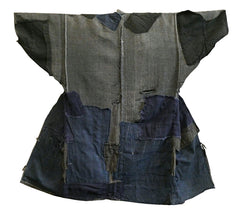A Tattered, Heavily Patched and Mended Cotton Kimono: Machine and Hand Patching
early twentieth century
shoulder to hem x sleeve tip to sleeve tip: 41" x 44 1/2", 104 cm x 113 cm
This intensely repaired, tattered and mended cotton kimono is shown inside-out in order to fully expose all the amazing repairs that have been applied to this garment over time.
The base is a grey-toned cotton kimono that is woven in a check pattern. As can be seen by looking at the detail photos here there is some loss to the kimono especially in the area of the sleeves and on the proper back.
There is also a tremendous amount of patched repair to the coat as probably more than 1/3 of the surface area--or almost 1/2--is covered in patching.
You will note that some of the repair was done with white thread and is machine stitched.
This is an interesting detail to consider because it shows that this kind of repair to garments was being being done on a mass scale in Japan well into the mid twentieth century.
This is not to say that the sewing machine was newly introduced to Japan then--sewing machines were used in Japan starting in the first decade of the Meiji era (1868-1912)--however this is just to say that as technology changed the basic activities and needs of people remained the same and these activities adapted to new, available methods.
There is so much visual appeal to this boro kimono, from the amazing repair, to the colors of the cottons, to the shapes of the patches, to the contrast of the white stitching to the purplish and blue patches.
The garment has been repaired hard and its original shape has been torqued. It is probably not easy to wear but it is amazing to look at, to display and to admire.
Recommended.


